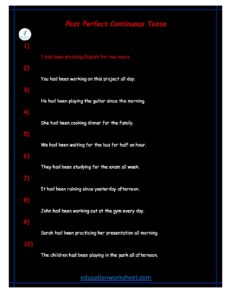how to converting Past Perfect Tense negative sentences to positive form
how to converting Past Perfect Tense negative sentences to positive form
The Past Perfect tense is a grammatical construction used to indicate that an action was completed before another past action or time. In English, forming negative sentences in the Past Perfect tense requires the use of “had not” or “hadn’t” in conjunction with the past participle of the main verb. Converting these negative sentences to positive form is a straightforward process that involves changing the “had not” to “had” and maintaining the past participle of the main verb. This transformation helps emphasize the completion of an action in the past. Below is a detailed description of how to convert Past Perfect negative sentences into their positive counterparts.
Understand the Past Perfect Tense

Before converting negative sentences to positive form, it is essential to grasp the concept of the Past Perfect tense. The Past Perfect tense is used to describe an action that occurred before another past action or time point. It is formed by using “had” followed by the past participle of the main verb.
Identify the Negative Past Perfect Sentence

To convert a negative Past Perfect sentence into a positive one, you must first identify the sentence’s negative elements. These typically include “had not” or “hadn’t” plus the past participle of the main verb.
Replace “Had Not” with “Had”
The primary change when converting a negative Past Perfect sentence to a positive one is to replace “had not” or “hadn’t” with “had.” This change eliminates the negation and transforms the sentence into a positive statement.
Retain the Past Participle Verb Form
The past participle verb form remains the same in the converted sentence. You do not need to modify the past participle when changing from a negative to a positive Past Perfect sentence. The past participle of a verb is used to indicate the completed action.
Adjust Sentence Structure and Comprehension

Finally, ensure that the resulting positive Past Perfect sentence still conveys the intended meaning. The action described should be clearly positioned as occurring before another past action or time point. Check the sentence structure and overall context to ensure that the conversion accurately reflects the intended message.
Example Conversion:
Original Negative Sentence: “They hadn’t finished their work before the meeting.”
Converted Positive Sentence: “They had finished their work before the meeting.”
In this example, the negative “hadn’t” is changed to the positive “had,” and the past participle “finished” remains the same. The conversion maintains the Past Perfect tense and correctly conveys the idea that the work was completed before the meeting.
Converting Past Perfect negative sentences to positive form involves changing the negation and keeping the same past participle form. This transformation helps to communicate past actions and their sequence more effectively in English grammar.

